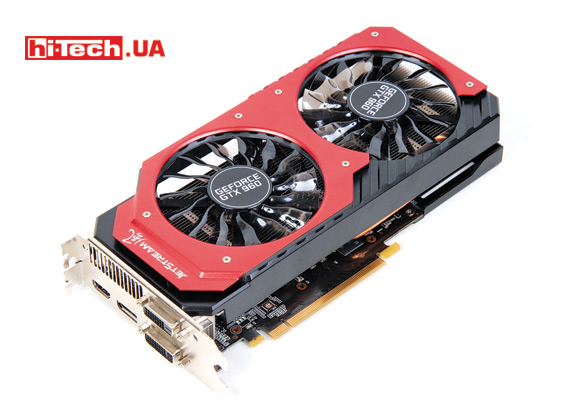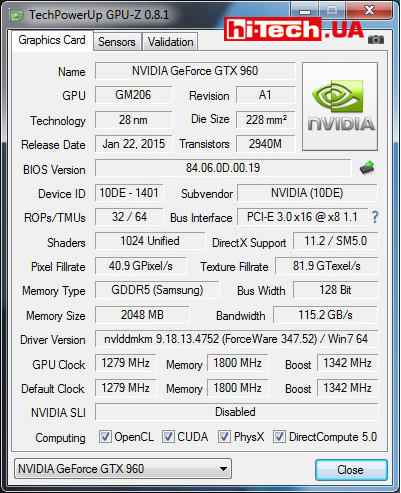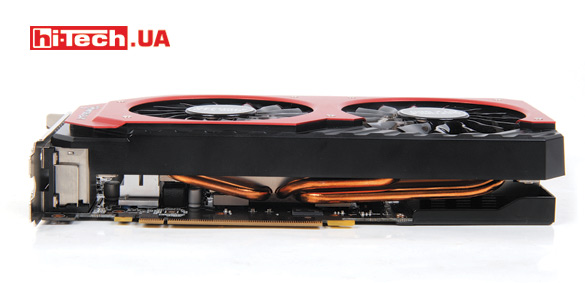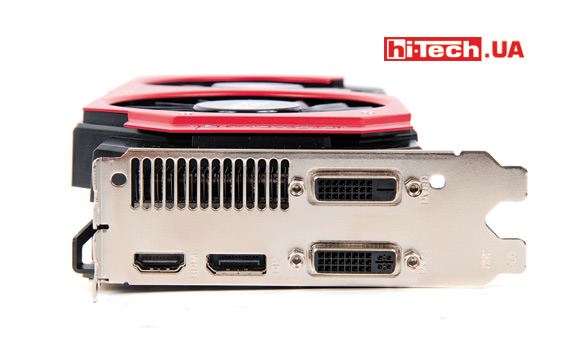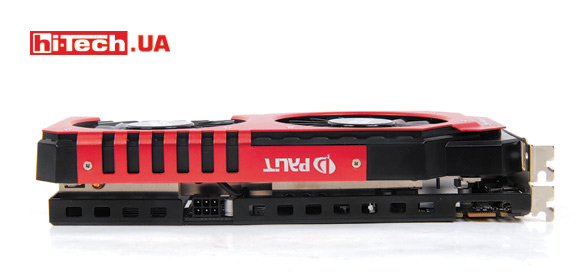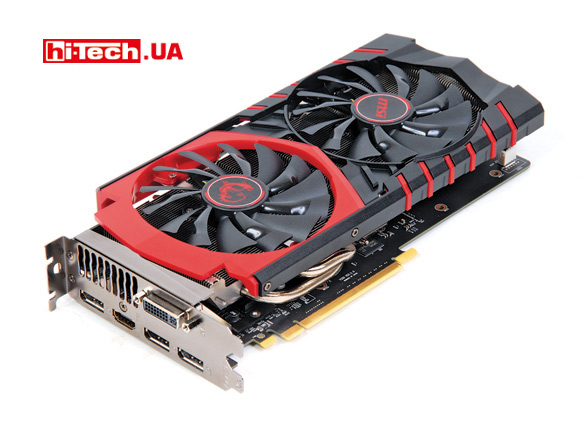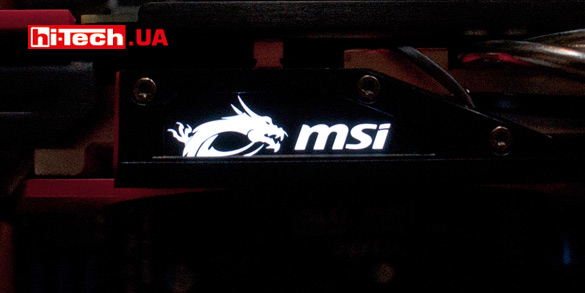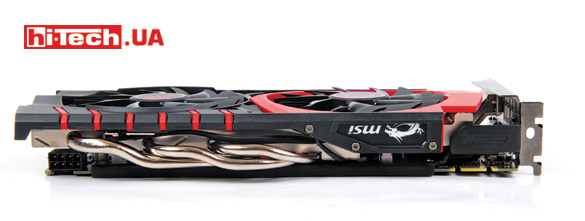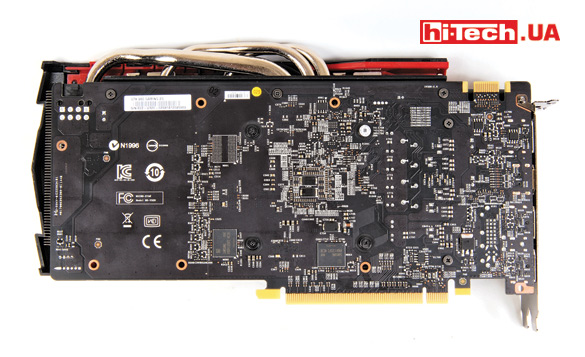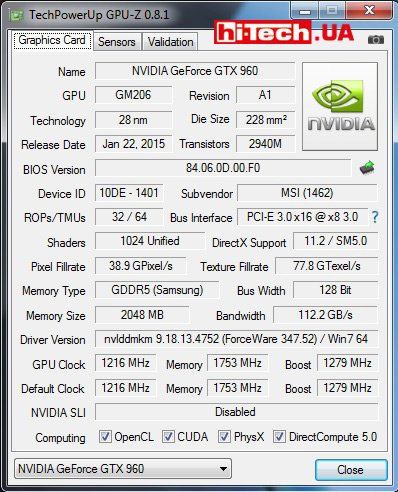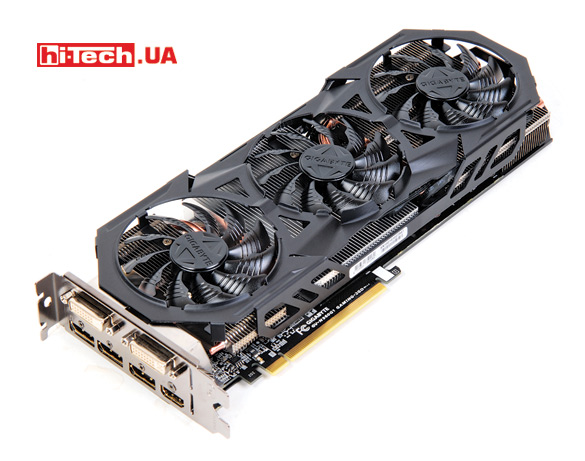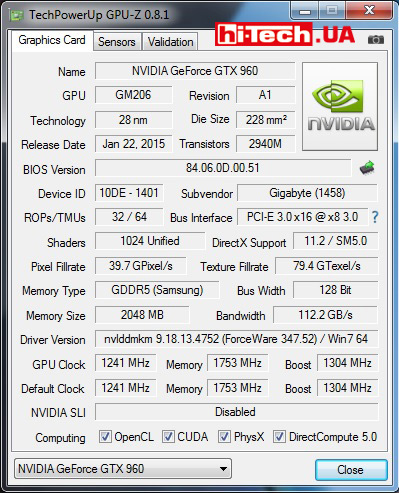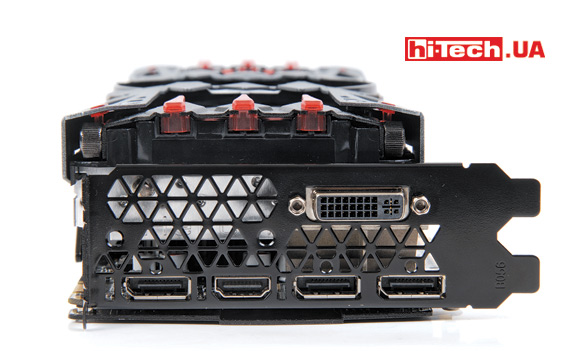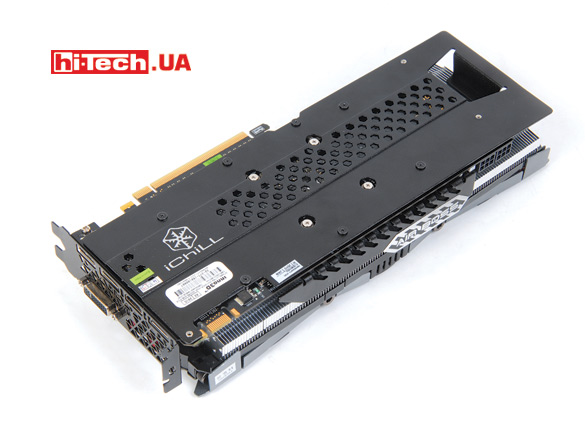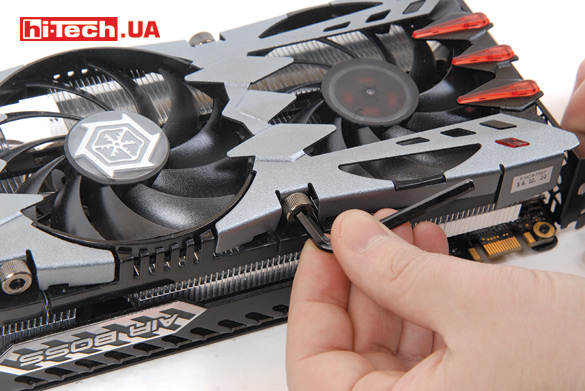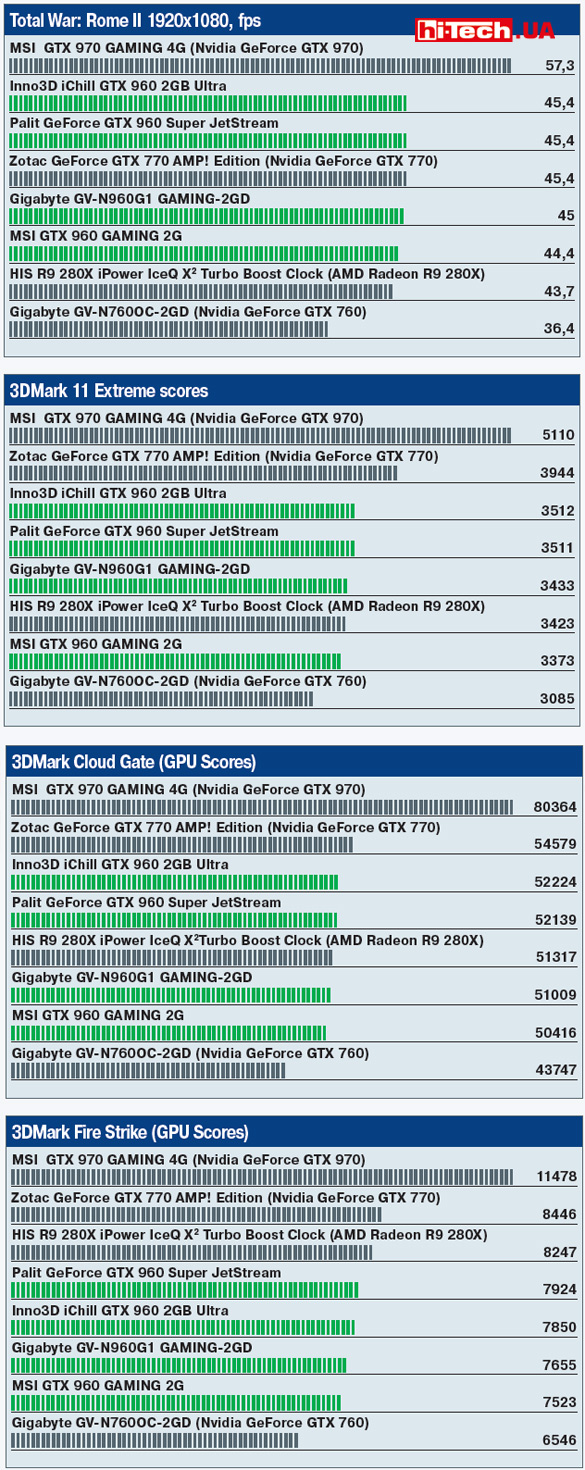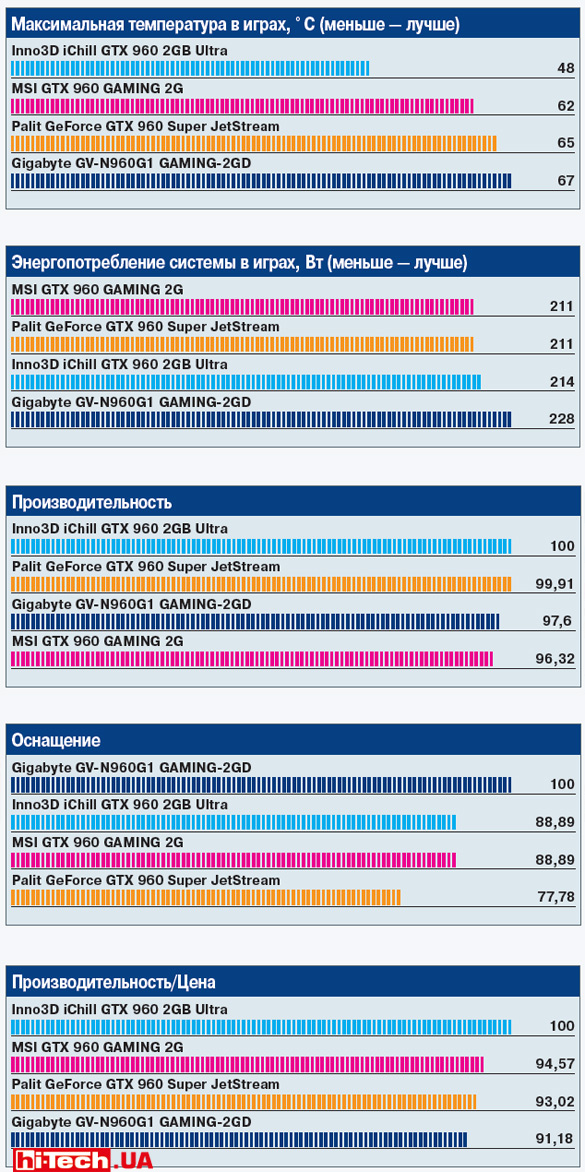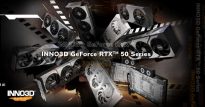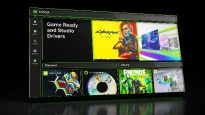NVIDIA GeForce GTX 960 video cards сomparative test
10.04.15Following the top category video cards NVIDIA GeForce GTX 980 and GTX970, simpler options based on the new NVIDIA Maxwell 2.0 architecture began to appear on the market. We are talking about accelerators based on NVIDIA GeForce GTX 960. How successful were such models?
Video cards based on the NVIDIA GeForce GTX 960 are replacing the very successful GTX 760. The graphics processor they use is called GM206 and, as is often the case, is a stripped-down version of the GM 204-A1 processors from more powerful video cards. In this case, NVIDIA GeForce GTX 980 and 970 video cards.
Instead of 5.2 billion transistors in the GTX 980 and 970, the GTX 960 graphics processor contains 2.9 billion. The number of computational pipelines, texture units and rasterization units is reduced (see table), and a more modest 128-bit memory bus is used.

NVIDIA GeForce GTX 960 reference specs compared to GTX 980, GTX 970, and GTX 760. Note how different the clock rates are between the reference GTX 960 and the GTX 960-based cards featured in this test.
It is not entirely correct to directly compare the characteristics of the GTX 960 and GTX 760, because they are built on processors with architectures of different generations. The halving of the memory bus width from 256 to 128 bits in the GTX 960 compared to the GTX 760 is a little confusing. But, if we look ahead a little, we can conclude that the new Maxwell 2.0 architecture made it possible to level out this feature and the GTX 960 turned out to be definitely faster than its predecessor GTX 760.
Set of capabilities
As for functionality, video cards based on the GTX 960 are approximately equivalent to the previously released NVIDIA GeForce GTX 980 and GTX 970. Still, these are video cards of the same generation. It provides support for DirectX 12 and VXGI (Voxel Global Illumination) lighting calculation technology. Improvements have been made to the video encoding and decoding unit. There is support for the new H.265 codec. By the way, the older GTX 980 only supports H.265 encoding, while the GTX 960 supports both H.265 encoding and decoding.
The HDMI 2.0 and DisplayPort version 1.2 interfaces provide support for resolutions up to 4096×2160 and 5120×3200 pixels, respectively, at a screen refresh rate of 60 Hz. Video cards allow you to simultaneously connect up to four monitors with a random choice of connectors.
G-Sync technology is supported, allowing you to synchronize the frame rate in the game and on your monitor (gaming monitors with G-Sync support). Read more about how G-Sync works in our test of gaming monitors.
Quiet and economical
One of the main advantages of the NVIDIA Maxwell 2.0 architecture is the high energy efficiency of GPUs. We have already pointed this out in the review GTX 980 and 970 and the GTX 960 was no exception.
The TDP of a standard GTX 960-based graphics card is only 120 W. For comparison, the TDP of the predecessor GTX 970 is 170 W. This means lower power supply requirements, lower heat generation and power consumption, and the ability for manufacturers to create very compact but fast systems based on the GTX 960 that can be successfully used for gaming. Miniature PCs are trending today.
According to our measurements, the power consumption of the entire system (without a monitor) in games using a video card based on NVIDIA GeForce GTX 960 was about 215 W. For comparison, the same system with a GTX 760 installed already consumes about 245 W.
Regular GTX 960 models use just one additional six-pin connector to provide sufficient power.
GTX 960 video cards
In our test, we collected four video cards based on NVIDIA GeForce GTX 960 from different manufacturers. The video cards turned out to be very interesting. All are equipped with proprietary cooling systems and operate at higher frequencies compared to the reference GTX 960.
Due to the high energy efficiency of GPUs, it is now possible for the video card to operate completely silently if there is no corresponding load. All presented models have this functionality.
Fans start and stop based on GPU temperature. In different models of video cards, the temperatures at which the fans stop and start turned out to be different.
In general, even under load, GTX 960 video cards are very quiet. You are unlikely to be able to distinguish the noise of their operation from the background noise of other system components (processor cooler, power supply fan, hard drive, etc.). These are conclusions obtained when using video cards with proprietary, more efficient cooling systems. We cannot say how GTX 960 models with standard NVIDIA turbine coolers will behave, since we have not received such models. But probably such options will not create noise problems.
The standard set of video outputs for the GTX 960 is one DVI, one HDMI 2.0 and three DisplayPort 1.2. If you plan to connect two monitors to the system at once and these monitors do not have HDMI and DisplayPort connectors (this situation is quite possible even taking into account the current proliferation of HDMI and DisplayPort), then you will encounter difficulties. Some manufacturers took this possible situation into account and equipped their models with a DVI pair. For example, we can cite the Gigabyte GV-N960G1 GAMING-2GD and Palit GeForce GTX 960 Super JetStream models.
Compare
We had at our disposal the Gigabyte GV-N960G1 GAMING-2GD, Inno3D iChill GTX 960 2GB Ultra, MSI GTX 960 GAMING 2G and Palit GeForce GTX 960 Super JetStream video cards.
Comparison table of characteristics
Palit GeForce GTX 960 Super JetStream
The Palit Super JetStream line of video cards traditionally stands out for significantly increased frequencies, and this model is no exception. According to the declared frequency values (standard and in Boost mode) for the GPU, the video card in our test was second only to the Inno3D iChill GTX 960 2GB Ultra model. It is curious that the maximum GPU frequency in games of the Palit GeForce GTX 960 Super JetStream and iChill GTX 960 2GB Ultra video cards was identical 1430 MHz. Palit, together with Inno3D, also distinguished themselves by increased video memory frequencies. The rest of the video cards in the test have a standard video memory frequency.
High frequencies provided the video card with excellent performance. According to this parameter, the Palit GeForce GTX 960 Super JetStream took second place, only slightly behind the leader. The difference is so small that it may well fit into the measurement error.
The trump card of Palit video cards is often their relatively low cost, but in this case, in the “performance/price” category, the Palit GeForce GTX 960 Super JetStream took only third place. However, we recommend that you read the separate commentary on the “performance/price” category and the cost of the video cards presented for testing in the section “How we tested video cards based on NVIDIA GeForce GTX 960” of this test.
The device does not stand out for its large size, but you can notice that the cooling system protrudes slightly beyond the second slot.
Having sacrificed a pair of DisplayPort connectors, the video card was equipped with a second DVI video output. If you need to connect a pair of monitors via a DVI connection, this solution is justified. By the way, it was precisely because of the relatively small total number of video outputs in the “Equipment” category that the video card ended up in last place.
The board design turned out to be the simplest in the test. GPU power supply is three-phase, as in the reference model. The rest of the test participants can boast of an increased number of power phases.
The cooling system does its job well. The video card does not make noise, and the maximum temperature in games was 65 ° C. If the GPU temperature drops to 30 °C (for example, when there is no load), the fans stop. They will start again if the temperature rises to 45°C. 30 °C is a fairly low value, and if the room temperature is high and the ventilation of the PC case is poor, the GPU temperature may not drop to this value. When the video card is running, the fans are illuminated, which may appeal to owners of cases with transparent windows.
Due to the significantly increased frequencies, the Palit GeForce GTX 960 Super JetStream out of the box will be faster than many video cards based on the GeForce GTX 960. If you don’t plan to experiment with overclocking, this is a good option. But it’s difficult to recommend it to enthusiasts due to the relatively poor preparation of the board.
Pros and cons:
+ among the leaders in performance
+ fan lighting
- relatively poor board preparation
- quite low temperature at which the fans turn off
MSI GTX 960 GAMING 2G
The MSI GTX 960 GAMING 2G video card is a classic representative of the MSI GAMING series video cards with all their features.
This involves the use of a modified board with special components that the manufacturer classifies as Military Class 4, the use of a proprietary cooling system, in this case TWIN FROZR V, and the ability to slightly overclock the GPU using the MSI Gaming App without affecting the warranty.
MSI GTX 960 GAMING 2G will occupy no more than two slots when installed in the system. Notice the MSI GAMING Dragon logo. When the video card is operating, it is illuminated, and you can choose different lighting options (constant, flickering, smooth change in brightness, etc.). One eight-pin connector is provided for additional power. An eight-pin power plug is required when overclocking a video card, and in normal mode the MSI GTX 960 GAMING 2G will work fine with a six-pin one.
The maximum GPU temperature in games was 62 °C. Like the other graphics cards in this review, the MSI GTX 960 GAMING 2G can run completely silently unless there is a corresponding load. More over the board can stay in silent mode much more often and much longer than others. The fact is that the fan switch-off temperature here is approximately 50 °C, and the fan switch-on temperature is 60 °C. Other video cards in this test turn off the fans at temperatures of 30°C or slightly higher.
In addition, the MSI GTX 960 GAMING 2G fans operate independently and are controlled based on temperature data collected from different areas of the board.
The GPU frequencies of this video card are increased, but compared to other participants in this test, the increase turned out to be the most modest, which naturally affected the performance results.
MSI GTX 960 GAMING 2G is an excellent balanced video card with some margin of reliability for experiments. But the factory overclocking turned out to be not as powerful as that of other test participants.
Pros and cons:
+ the most successful, in our opinion, control algorithm for stopping and starting fans
+ logo backlight control
- relatively modest factory “overclocking”
Gigabyte GV-N960G1 GAMING-2GD
At first glance, what immediately catches your attention is not a two-fan, but a three-fan cooling system. Under load, the video card operates very quietly, however, we can characterize the performance of other video cards in this comparative test in the same way.
The maximum GPU temperature in games was 67 °C. This is a good result, but we expected slightly better results from such a developed cooling system. The fans stop when the GPU temperature drops to 31 °C. They unwind again when the temperature rises to 40–45 °C. If these temperature values were higher, the video card would work absolutely silently longer.

When the fans stop for silent operation, additional sections “Silent” and “Stop” light up on either side of the illuminated WINDFORCE inscription.
GPU frequencies have been increased significantly, but our video card company is not an easy one and, for example, Palit and Inno3D have even higher frequencies. The manufacturer indicates that for this series of video cards, GPUs are screened out in a special way and the most successful copies are selected, which potentially provides some additional confidence in successful overclocking. Memory frequency is standard.
The board has been significantly redesigned using proprietary Ultra Durable VGA technology. Powerful six-phase GPU power supply is used. The rest of the test participants can boast of a maximum of four-phase power supply.
During tests, we noticed that the system with the Gigabyte GV-N960G1 GAMING-2GD installed consumed about 15 W more power than the same system with other GTX 960-based video cards. This is not at all critical, but it’s an interesting point.
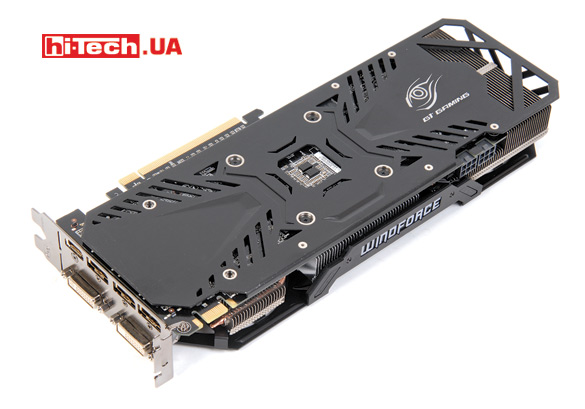
Among the proprietary features, one can also note the use of two BIOS chips at once. As we understand, if something goes wrong when experimenting with the BIOS, you can always play it safe with a second chip.
Gigabyte GV-N960G1 GAMING-2GD pleased us with the largest number of video outputs. To the standard set for the GTX 960, consisting of DVI, HDMI and three DisplayPorts, another DVI has been added. This explains the highest score in the Equipment category.
In terms of performance, the Gigabyte GV-N960G1 GAMING-2GD took third place, slightly behind the higher-frequency Inno3D and Palit.
The Gigabyte GV-N960G1 GAMING-2GD is an interesting, fast video card with potentially good overclocking capabilities and a number of proprietary features that can be really useful.
Pros and cons:
+ interesting proprietary features (dual BIOS, additional DVi video output)
+ advanced board
- quite low temperature at which the fans turn off
Inno3D iChill GTX 960 2GB Ultra
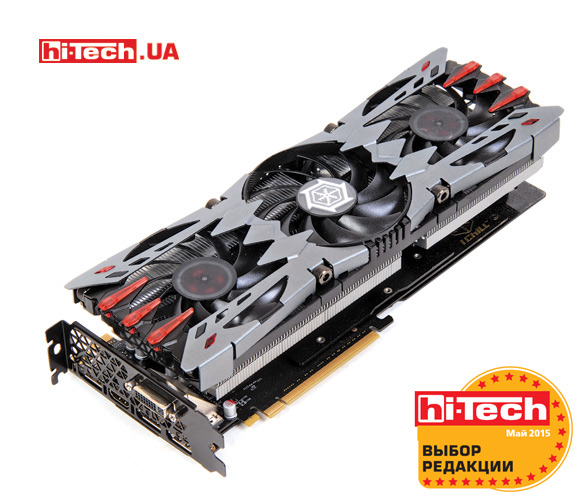
Inno3D iChill GTX 960 2GB Ultra graphics card. With such an aggressive design, the graphics card, rather surprisingly, does not illuminate in any way during operation
Compared to other test participants, the Inno3D iChill GTX 960 2GB Ultra turned out to be simply huge. It seems that this is not a middle-class video card, but some kind of higher-class accelerator.
In our opinion, the designers went a little overboard with such an aggressive design. Externally, I liked the video card least of all. But this is a matter of personal preference. I was a little surprised that during operation neither the fans nor any board elements are illuminated. With such a modding design, this was expected.
The large dimensions are due to the use of a very powerful cooling system. In her work, she turned out to be the most effective among other test participants. Under load in games, the GPU temperature was only 48 ° C. This cooling system can be safely installed on more powerful video cards.
The disadvantages of the cooling system include its large size. The video card will take up three slots in the system, and due to its large length, there may be problems when installed in some not very spacious cases.
The fans turn off at a fairly low temperature of 32 °C. But due to such an advanced cooling system, the GPU temperature drops quickly and the video card, accordingly, quickly switches to silent operation. The fan switches on at a temperature of about 40 °C.
The board itself has been slightly redesigned. Instead of a three-phase one, a four-phase GPU power supply system is used.
The set of video outputs for the Inno3D iChill GTX 960 2GB Ultra turned out to be standard for a video card based on the GTX 960. But the package is quite interesting: in the box you can find a gaming mouse pad and a hexagon for removing some elements of the cooling system.
The highest GPU frequencies and increased memory frequencies allowed the Inno3D iChill GTX 960 2GB Ultra to prove to be the test leader in terms of performance. Combined with the most efficient cooling system, interesting package and competitive price, we considered this a sufficient set of properties due to which theInno3D iChill GTX 960 2GB Ultra receives our Editors’ Choicein the test of video cards based on NVIDIA GeForce GTX 960.
Pros and cons:
+ among the leaders in performance
+ highest efficiency cooling system
+ interesting equipment
- controversial design
- large dimensions
How we tested video cards based on NVIDIA GeForce GTX 960
The test applications included synthetic benchmarks 3DMark 11 (Extreme preset), 3DMark with Cloud Gate and Fire Strike tests, and the games Sniper Elite V2, Metro: Last Light, Sleeping dogs, Tomb Raider 2013, Total War: Rome II. The games used maximum or close to maximum graphics quality settings with a resolution of 1920×1080.
We also measured the maximum temperature of the GPU in games and the maximum power consumption of the system (the entire test system without a monitor, and not a separate video card) when installing different video cards.
Histograms are normalized as percentages, with models sorted by test results. Specific results in the form of points and FPS are also indicated.
Video cards based on NVIDIA GeForce GTX 960 were tested using the latest driver version. Video card performance results MSI GTX 970 GAMING 4G (Nvidia GeForce GTX 970), HIS R9 280X iPower IceQ X2 Turbo Boost Clock (AMD Radeon R9 280X), Zotac GeForce GTX 770 AMP! Edition (Nvidia GeForce GTX 770), Gigabyte GV-N760OC-2GD (Nvidia GeForce GTX 770) are given for comparison and obtained in tests that we carried out earlier. The settings of the test applications did not change, but please note that the driver versions for the GTX 960 video cards and the video cards shown for comparison from previous tests are different.
When calculating the overall scores for the Performance category, the results of all tests are given equal weight.
Please note that Performance/Cost histograms are based on device vendor prices for this test. We asked to provide us with prices at the level of large Ukrainian online stores. These are approximate prices, and when choosing, we recommend checking the latest information on the cost of video cards.
Test platform configuration:
| Processor | Intel Core i7-3770K |
| Motherboard | Biostar Hi-Fi Z77X |
| RAM capacity | 4×2 GB DDR3 1333 |
| Storage | SSD Adata S511 120 GB |
| Operating system | Windows 7 64 bit |
| Monitor | Samsung SyncMaster 245T |
| Power supply | Thermaltake Thoughpower 1500W (TP-1500M) |
Test results

All GTX 960-based video cards in our test can turn off the cooling system fans, thereby ensuring silent operation when there is no load. Here are the GPU temperature measurements at which the fans are turned off and activated in the tested video cards
Conclusions
If we compare video cards based on NVIDIA GeForce GTX 960 with their predecessors GTX 760, the new products will be noticeably faster in most tests using Full HD resolution. In addition, they are more economical, more functional, many are equipped with the ability to operate silently without load, and despite the fact that the cost of the GTX 960 and GTX 760 is currently approximately the same.
The fastest GTX 960 models can even rival the GTX 770 in some tests. But overall, as tests have shown, the previous generation of top-tier graphics cards remain faster than the new mid-range GTX 960 graphics card.
The GTX 960 is a good mid-range graphics card option.
As for the test participants, any of the presented models will not disappoint you. Palit GeForce GTX 960 Super JetStream uses the simplest board, but due to its high frequencies it demonstrates excellent performance out of the box. The MSI GTX 960 GAMING 2G is an excellent example of a well-balanced, reliable graphics card. In our test, it was let down by a relatively small factory overclock – the other participants turned out to be very advanced in this regard.
The Gigabyte GV-N960G1 GAMING-2GD pleased us with both its speed and set of features that other participants could not boast of in this test.
And the simply huge Inno3D iChill GTX 960 2GB Ultra is a leader in the performance and efficiency of the cooling system.
Engineer of the Test Laboratory
Don't miss interesting news
Subscribe to our channels and read announcements of high-tech news, tes
Oppo A6 Pro smartphone review: ambitious

Creating new mid-range smartphones is no easy task. Manufacturers have to balance performance, camera capabilities, displays, and the overall cost impact of each component. How the new Oppo A6 Pro balances these factors is discussed in our review.
Editor’s Choice 2025. Best devices of the year by hi-tech.ua

The best gaming laptops, mice for work, gaming keyboards, smartphones, and wireless headphones of 2025. Among them, we will highlight the most interesting ones and those that we can recommend buying.
Xiaomi Watch 5 is the first smartwatch with two medical sensors at once smart watches Xiaomi
Xiaomi Watch 5 will be the senior solution in the brand’s device line. The watch is built on the Qualcomm Snapdragon W5 platform
Lenovo Adaptable Keyboard can adapt the pressure of pressing keyboard Lenovo mouse
Lenovo uses an optical actuation mechanism in this model, which allows you to change the key travel and response characteristics.






